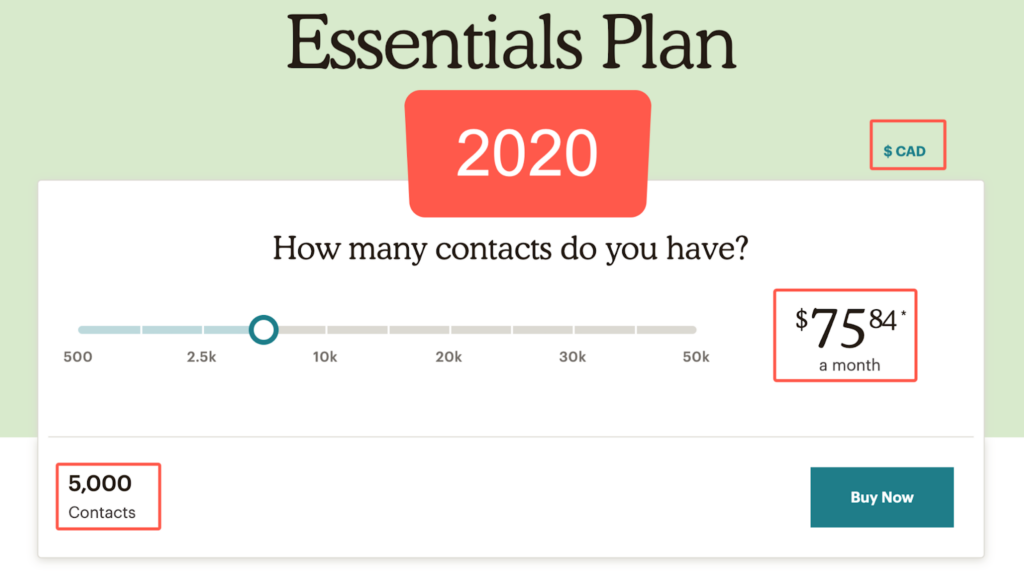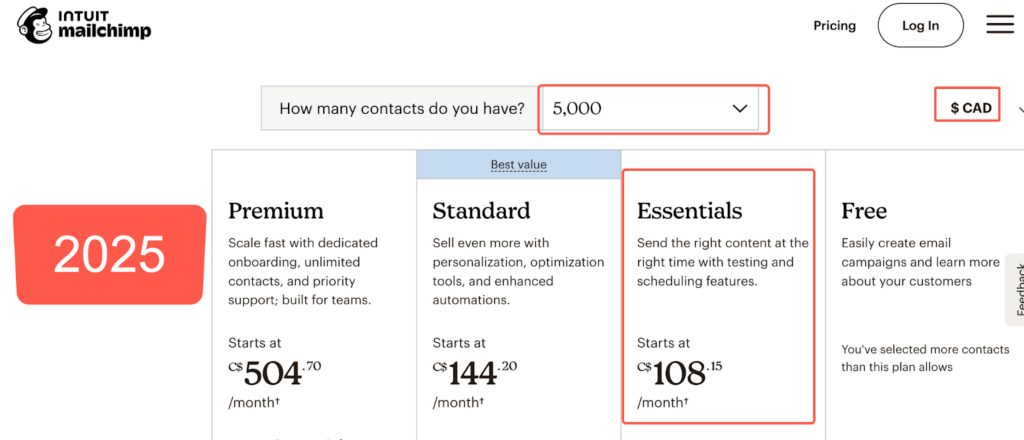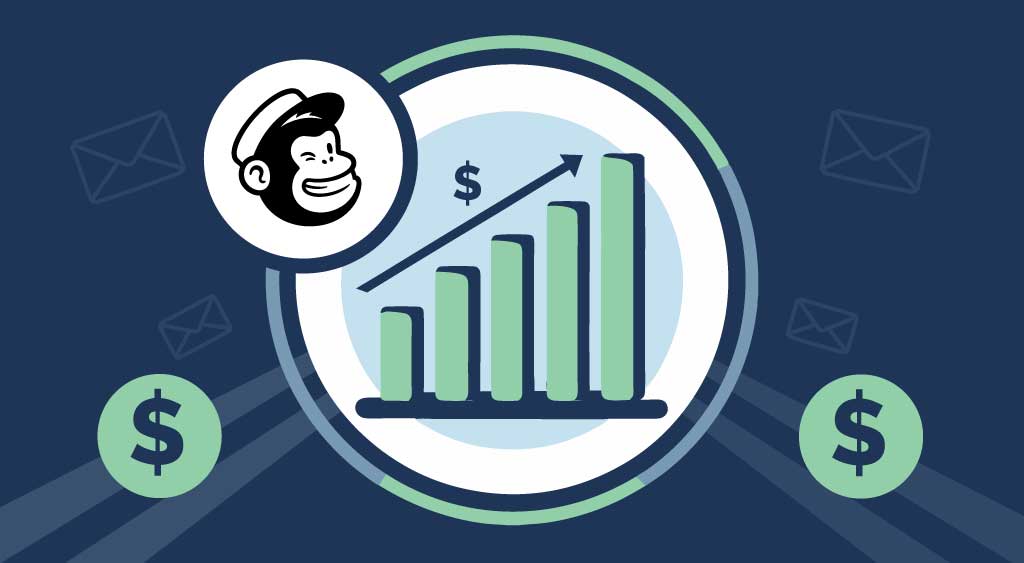Mailchimp’s near monopoly in the email marketing software category has made accounts expensive and they show no signs of slowing down. Intuit’s acquisition of Mailchimp in 2021 only accelerated price increases.
Their pricing model is (deliberately?) difficult to understand. Overages apply. And chances are you’re paying for features you don’t use. Add in currency conversion rates and being charged for unsubscribed contacts and the numbers start to look alarming:
- 6%: Mailchimp’s average annual price increase.
- 7% increase due to USD to CAD conversion rate in 2025.
- 13% of contacts unsubscribe each year. Mailchimp continues to count these contacts for billing purposes.
Here are 5 reasons why you should consider an alternative email marketing and communications software – especially if you’re looking for a Canadian alternative.
- Mailchimp is expensive. So are other popular email software.
- Mailchimp pricing has increased by 6% every year in the past five years
- Changing cost due to currency conversions fluctuations
- Complex pricing model makes it difficult to project total cost
- You are billed for unsubscribed and “non-subscribed” contacts
Mailchimp is expensive. So are other popular email software.
The cost of a Mailchimp account is higher than what you pay for a Canadian alternative.
Let’s take the Standard Plan with 5,000 contacts. With Mailchimp it’s CAD $144/mo as of January 2025. The comparable Standard Plan is CAD $150 for a Constant Contact account. The comparable plan for Campaign Monitor is $148/mo. (It’s almost as if these prices are made to match.)
They are considerably more expensive than Envoke — a Canadian Mailchimp alternative. See a full comparison here between Mailchimp and Envoke.

Mailchimp pricing has increased by 6.1% every year in the past five years
In January 2020 Mailchimp’s Essentials Plan cost CAD $75.84/mo. The same plan is CAD $108.15 in 2025. That’s a 44% increase which is the equivalent of an annual increase of 6.1%.


Currency conversions fluctuations
Currency conversion fluctuations mean paying a different amount each month if you’re billed in a currency other than USD.
The example below shows a 7% increase from January 2024 to January 2025 based on conversion rate alone from USD to CAD.

Complex pricing model makes it difficult to project total cost
Mailchimp’s pricing plans are not trivial to understand. There are overages, monthly sending limits, support limitations and lots of fine print to read through.
It’s easy to start on a free or cheap plan, but before you know it, you’ll be forced to upgrade to higher tiers to use features that really move the needle. This makes it challenging to estimate your annual cost upfront.
This is in stark contrast to Envoke’s pricing, which is deliberately straightforward so you know how much you’ll pay to start with and how much you’ll pay in a year and beyond.
You are billed for unsubscribed and “non-subscribed” contacts.
“Subscribed, unsubscribed, and non-subscribed contacts are included in your contact count.”
Source: Mailchimp’s FAQ page
Mailchimp considers unsubscribed contacts as part of the list count when it comes to calculating contacts for billing purposes because these unsubscribed contacts can potentially receive transactional emails, such as purchase confirmation messages.
In reality, few do. Most contacts are sent bulk emails (email campaigns or e-blasts) that cannot reach unsubscribed contacts. The result is that you end up paying for contacts that your e-blasts aren’t sent to. It works the same for non-subscribed contacts, who, unlike unsubscribed contacts, never opted-in to receive emails from you.
What does this mean for your monthly payments?
Mailchimp’s self-reported average unsubscribe rate is 0.27% for each e-blast. If you send a email to your contacts once a week then 13.58% of them will have unsubscribed by the end of the year. The result: Each year you end up with 13.58% more contacts that count for billing purposes than you can actually send e-blasts to.
It shouldn’t come as a surprise at this point to learn that Envoke’s pricing model doesn’t count unsubscribed contacts for billing.
Mailchimp Alternatives
If you Google “alternatives to Mailchimp,” you’ll see dozens of alternatives and comparison websites. In reality these platforms are quite similar once you read through the features lists. With most of the US-based alternative software, you’ll end up with a similar monthly fee and similar functionality.
If you’re looking for a Canadian alternative to Mailchimp, the options are far more limited. Envoke is such Canadian alternative. In addition to being a Canadian company and data storage in Canada, Envoke also allows sending mandatory messages that reach contacts with important emails—even if they’re unsubscribed from newsletters. And multiple departments can be connected to one umbrella account, which is useful for larger organizations where giving access to all users to one large email list is not an option.
Here are a few testimonials from customers who have switched to Envoke from Mailchimp. You can find more on our website.

The product is great, but what's even better is the very accessible and responsive support team and resources that enable me to continually customize Envoke to suit my needs perfectly.

Envoke is a communication tool rather than a marketing tool - this is unique when it comes to email campaign products. It fits our needs far better than any alternative product.

I have been using the Envoke for over 2-years now and have seen nothing but improvements.
Summary
If you haven’t been looking for a Canadian Mailchimp alternative yet, you may be now. In order to escape Mailchimp’s predatory pricing model, Envoke may be a good fit.
It’s not for everyone, so use this comparison page to review key differences. Hint: If you need a website builder, eCommerce integrations, and sales automations, then Envoke isn’t for you. If you do want to try Envoke you can start a free trial here.
